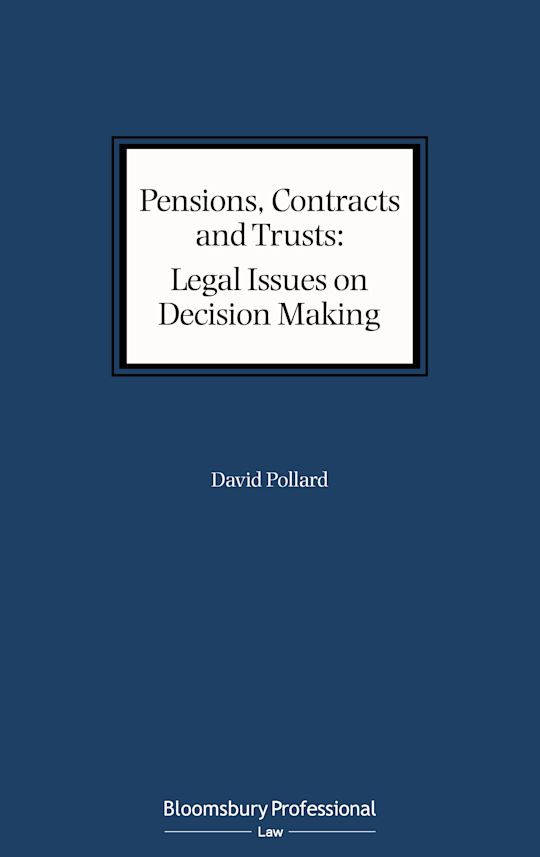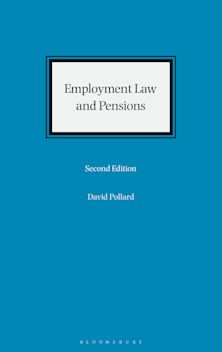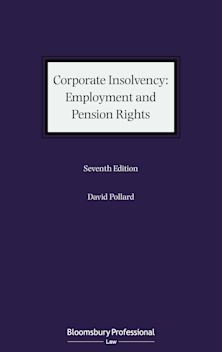Pensions, Contracts and Trusts: Legal Issues on Decision Making
Pensions, Contracts and Trusts: Legal Issues on Decision Making
Description
This is a topical area for the courts, which have moved to imply various limitations or tests on decision makers powers and when they can be challenged. This is made more difficult for lay users and lawyers alike in that implied restrictions are (by definition) not apparent from the words of the relevant contract itself.
These limits are applied by the courts not just to fiduciaries (such as trustees or directors), but also to non-fiduciaries (eg banks and employers).
Recent case law includes:
· Pitt v Holt (SC) – trustee decisions (2013)
· Braganza (SC) – contractual discretions (2015)
· Eclairs (SC) – directors powers: proper purposes (2015)
· IBM UK Holdings v Dalgleish (CA) – employer powers under pension plans (2017)
· British Airways (CA)– pension plan – proper purposes (2018)
The book reviews the relevant doctrines of:
· Interpretation rules
· Proper purposes;
· Due consideration of relevant factors
· Full perversity (no reasonable decision maker)
This title is included in Bloomsbury Professional's Pensions Law online service.
Table of Contents
1. Introduction
Part 2: Legal review of decisions: General
2. Legal review of decisions: Major Tests
3. Expanded outline of major tests
4. Exceptions and qualifications
5. Public Law analogy in private law discretions?
6. Construction – General
7. Interpretation of Pension Schemes
Part 3: Types of decision and who is the decision maker
8. Nature of discretion
9. Who is the decision maker?
Part 4: Proper Purposes – Applying Eclairs
10. Proper purposes: Introduction
11. Eclairs
12. The proper purpose test
13. Purpose test in Trust Law and Company Law
14. How is the proper purpose test applied?
15. Can proper purposes apply where there has been a failure to act?
16. How is the decision maker's purpose worked out?
17. Causation/More than one motive or intention
18. More than one decision maker
19. Purpose verses motive?
20. Effect of improper exercise
21. Proper Purposes: Conclusion
Part 5: Proper Purposes – Application to Pension Schemes
22. Proper Purposes and pension schemes: Introduction
23. Pension scheme and Trustee powers
24. Overall Purpose of a pension scheme
25. Pensions: Main purpose verses Sole purpose?
26. Pension trusts: Examples of the application of the proper purpose test
27. Pension schemes: Amendment powers/Change of Principal
28. Transfers-in
29. Transfers out: Fletcher Challenge and ITS v Hope
30. Investment
31. Early retirement reduction
32. Commutation factors
33. Pension increases
34. Winding-up a pension scheme?
35. Pension Regulator powers
36. Trustees exercising powers fairly
37. Pension Trustees and Proper Purposes: Overview
38. No literal 'best interests' duty for trustees
Part 6: Braganza 1: Due consideration of relevant factors
39. Braganza – a landmark case
40. Braganza: the Decision
41. The Braganza rationality Test
42. Trustees and Braganza: Beyond a Good faith test
43. Trustees and public law analogies following Braganza
44. Does Braganza apply to all commercial discretions?
45. Intensity of review
46. Braganza first limb – process: relevant factors
47. Trustees and relevant factors: Pitt v Holt compared with Braganza
48. Three types of relevant factors: the public law approach
49. Limits on enquiries: properly informed, but not an 'endless search'
50. Weight given to factors
Part 7: Braganza 2: No reasonable decision maker: Perversity
51. Braganza
52. Arbitrary, capricious etc
53. Timing for irrationality?
54. What if one reasonable decision maker would have made the same decision?
55. Braganza 2 test is a limit on a power?
Part 8: Braganza rationality tests: interaction with the proper purpose test
56. Braganza and proper purposes tests
57. Braganza and MDTC/Contractual/Imperial duty
Part 9: Further common issues on the proper purposes and Braganza tests
58. Multiple decision makers
59. Decision maker would have made the same decision anyway?
60. Decision maker giving reasons
Part 10: Remedies for a Failure?
61. Remedies
62. Fiduciary Duties
63. Reversal or cancellation of the decision: void or voidable
64. Damages or equitable compensation for breach of trust/duty
65. Impact on third parties
66. Removal of the decision maker
67. Exclusion clauses
68. Overturning a decision – reference back to decision maker
Part 11: Trustees and Directors: Fetters on Discretion
69. Discretions and fetters
70. Statements of a no fetter rule
71. Fetters: Some older cases
72. The Fetters rule gets more sensible: three modern cases: Thorby; Cabra Estates and Firkin-Flood
73. Fetters: Modern position
74. Pension schemes and fetters
75. Fetters: is public law any guide?
76. Fetters: Directors and Companies
77. Fetters and changes of trustees
78. Fetters: Outside parties
79. Fetters: Impact on Third parties
80. Fetters and a Power of amendment
81. Setting policies or guidelines?
Product details
| Published | 10 May 2020 |
|---|---|
| Format | Ebook (Epub & Mobi) |
| Edition | 1st |
| Extent | 360 |
| ISBN | 9781526511843 |
| Imprint | Bloomsbury Professional |
| Publisher | Bloomsbury Publishing |
Reviews

ONLINE RESOURCES
Bloomsbury Collections
This book is available on Bloomsbury Collections where your library has access.









